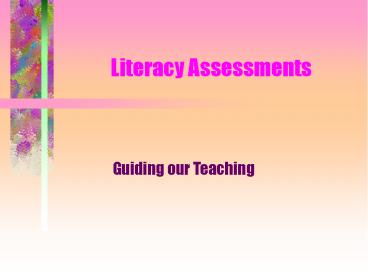Literacy Assessments - PowerPoint PPT Presentation
Title:
Literacy Assessments
Description:
Title: Literacy Assessments Author: UCA Last modified by: Tammy Benson Created Date: 9/17/2002 10:13:55 PM Document presentation format: On-screen Show – PowerPoint PPT presentation
Number of Views:171
Avg rating:3.0/5.0
Title: Literacy Assessments
1
Literacy Assessments
- Guiding our Teaching
2
Observe Childrens Responses
- For competencies and confusions
- for strengths and weaknesses
- for the processes and strategies used
- for evidence of what the child already understands
3
The Reading Process
- Involves messages expressed in language
- Involves knowing about the conventions used to
print language - Involves visual patterns -clusters of
words/syllables/blends/letters - The flow of language does not always make the
breaks between words clear and children may have
trouble breaking messages into words
4
Literacy Assessments
- Running Records
- Letter ID
- Concepts about Print - CAP
- Word Tests
- Writing
- Dictation
5
Text Difficulty Text Type
- Easy text (95-100 correct)
- Instructional Text (90-94 correct)
- Hard/Frustration Text (80-89 correct)
6
Learning to Take A Running Record
- Record everything the child says and does as he
tries to read the book (tape recorder) - Know the conventions/abbreviations
- Use ticks for each correct response
- Make a record of each child reading his three
little books or selections. - A sample reading of 100-200 words required
7
Analyzing Running Records
- Use conventions for scoring records
- Check directional movement
- Calculate the error rate
- Learn from childs error behavior
- Does the child use meaning, structure, visual
information, word memory??? - How about cross-checking strategies?
- Self checking?
8
Letter Identification
- Administration
- introduce task, point to each letter, ask
questions, move to other letters - Scoring the record
- Mark A for alphabetical response, S for sound or
W for word beginning similarly - record
everything child says-including incorrect - Interpretation of scores
9
Concepts about Print (CAP)
- Use Sand or Stones Book
- Follow directions exactly
- Measures knowledge about front of book, print
tells a story, letters, clusters of letters are
called words, first letters and last letters,
spaces, punctuation marks, upper and lower case
letters
10
Word Tests
- Administration - Read one list of words
- Use of test - will tell which children are
accumulating a reading vocabulary - Scoring - stanine scores
- Interpretation - can be used for grouping
children for skill teaching or to measure if
progressive changes are occurring in skills
11
Writing
- Ask children to write all the words they know -
can give them suggestions - Record Language level, message quality, and
directional principles - Interpreting the observation
- Connecting the progress between reading and
writing - visual differences in print
12
Dictation Task
- Ask children to record a dictated sentence
- Choose from five sentences
- Read slowly while child writes
- Record Score the writing
- Retesting - important for recording changes over
time
13
Summarizing the Observation Survey Results
- Book reading - Instructional Level?
- Analysis of strategies used by the child
- Useful strategies on text, with words, and with
letters - Write up the survey summary
- Read example - p. 77
- USE THE RESULTS IN TEACHING!!!!!!!!!!!!!!































